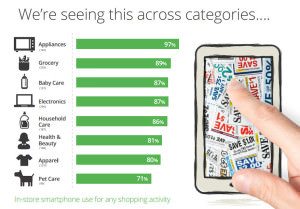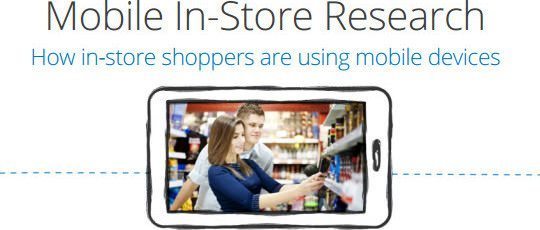As mobile search statistics soar, it’s no secret that smartphones are changing the landscape of retail. Shoppers use their smartphone to purchase products online, but also to research and compare brick and mortar stores. A new mobile in-store research study by the Google Shopper Marketing Agency Council and M/A/R/C Research examines the role of mobile as part of the shopping experience and the opportunities this presents.
 Mobile In-Store Research: Key Findings
Mobile In-Store Research: Key Findings
The study classifies 79% of smartphone owners as “Smartphone Shoppers“. These people are characterized by using their device a least once a month to assist with shopping. The mobile search can be conducted prior to shopping activities, or as the study reveals, 84% of smartphone shoppers use their device while in a physical store. These trends are not category specific and extend across all industries.
Reasons given for utilizing the smartphone include ability to research products saving time and money as well as making shopping tasks easier. Smartphone shoppers conduct mobile search to find directions to store locations, hours of operation and promotional offers. These shoppers help themselves instead of relying on a salesperson for information.
Search engines are incredibly important to mobile research. While a percentage of smartphone shoppers will go directly to a brand website, the overwhelming majority use search engines to find the information they need. This is especially true for users that what to find the location where a specific product is sold and make price comparisons between those locations.
Finally, the study finds that frequent smartphone shoppers spend more money when shopping. This can be as much as 50% more than those that occasionally or never use mobile search when shopping.
Mobile In-Store Research: Implications for Businesses
The Mobile In-Store Research Study finds four major implications for businesses. Google provides the following suggestions to make sure you businesses can capitalize on these findings:
1. Mobile marketing isn’t an option, it’s an imperative
In-store shoppers are looking for product information and they’re turning to their mobile device to find it. The mobile device, always on and always with shoppers, is one of the biggest influencers in the store today; it presents tremendous opportunities for marketers across industries to connect with potential customers–wherever they are, whenever they’re searching for your products.
2. Mobile can be used to get customers to the store and help keep them there.
Allow customers to find your business on mobile. In addition to having a mobile website, businesses should use it to prominently display retail locations and phone numbers.
Own the digital shelf – Make it easy for shoppers to find product information, promotional offers, or other information about your business on their smartphones when in-store.
Adapt your marketing message to the consumer’s context. Taking into account things like location, time of day and device allow you to reach people with more relevant messages.
3. Meet the showrooming challenge head-on.
Embrace mobile use in-store. It’s going to happen, so find a way to take advantage of it. Having a wide inventory of e-commerce products, store maps, and product information QR codes are just some of the ways to connect with mobile users.
Improve the in-store experience. Offering expert service from salespeople or interactive product demos can help distinguish your in-store experience from online shopping.
Have a strategy to address price comparisons. Using price match guarantees, stocking unique product bundles, and creating store specific brands and products are just some of the steps that businesses can take.
4. Recognize the pivotal role of mobile to your overall marketing strategy.
Embrace mobile use in-store. It’s going to happen, so find a way to take advantage of it. Having a wide inventory of e-commerce products, store maps, and product information QR codes are just some of the ways to connect with mobile users.
Improve the in-store experience. Offering expert service from salespeople or interactive product demos can help distinguish your in-store experience from online shopping.
Have a strategy to address price comparisons. Using price match guarantees, stocking unique product bundles, and creating store specific brands and products are just some of the steps that businesses can take.































